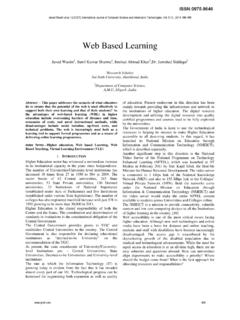Transcription of How much could I be earning? Using Occupational …
1 How much could I be earning? Using Occupational Employment Statistics data during salary negotiations Understanding how wages and wage distributions vary by occupation, industry, and location is invaluable information when negotiating a starting salary or requesting a raise at your current job. The Occupational Employment Statistics (OES) program produces hourly and annual wage estimates for nearly 800 occupations. Data shown here are from the OES May 2019 estimates, available at Find your occupation First, find your occupation. The OES Occupational profiles have a wealth of wage information for each of the nearly 800 occupations.
2 Each profile page includes the occupation's definition; national employment and wage estimates; and data by state and area, and by industry. Find and click on your occupation in the list at Whether you are a nurse, accountant, security guard, or electrician, the Occupational profiles will get you started in determining how much you could be earning. Each Occupational profile not only contains the average (mean) wage for the occupation, it also shows the wage distribution, which provides information on the spread of the wages. Percentile wages, including the 10th, 25th, 50th (median), 75th, and 90th percentiles, indicate how much the wages vary for an occupation.
3 For example, 10 percent of workers earn wages below the 10th percentile and 90 percent earn more than the 10th percentile. Eighty percent of workers earn wages between the 10th and 90th percentiles. The chart below shows the mean wage and the wage distribution for four different occupations. Where an individual's wage should fall within the national distribution depends on a number of factors. Of course, experience and education are factors. Someone new to the field may expect wages near the 10th or 25th percentile, whereas those with more experience and education could expect wages near the 75th or 90th percentile.
4 In addition, location is a very important factor in determining where you might fall in the wage distribution, and in many cases the industry also plays a role. Wages vary by location The geographic location affects wages because workers tend to earn higher salaries in large metropolitan areas, where a higher cost of living and other factors can drive wages upward. For example, the mean hourly wages for all four occupations in the chart below are highest in the San Francisco area, followed by Minneapolis. OES has wage data for approximately 580 states and areas.
5 The Occupational profiles have maps illustrating mean wages for all areas. Hovering over the area with your mouse provides that area's wage distribution. $70 Occupational wages in selected metropolitan areas, May 2019. $60 San Francisco-Oakland-Hayward, CA. Mean wage per hour $50 Minneapolis-St. Paul-Bloomington, MN-WI. $40 Fargo, ND-MN. $30 Montgomery, AL. $20. $10. $0. Registered nurses Electricians Bookkeeping, accounting, General maintenance and and auditing clerks repair workers Wages vary by industry Wages for workers in the same occupation can vary by industry.
6 This may be due to differences in working conditions, where industry employment is concentrated, whether or not unions are prevalent, and other factors. The table below illustrates how annual wages for computer systems analysts can differ considerably across industries. For example, wages for computer systems analysts in aerospace product and parts manufacturing tend to be high, while colleges, universities, and professional schools pay lower wages. Annual wages for computer systems analysts, by industry, May 2019. 10th 25th 75th 90th Industry Mean percentile percentile Median percentile percentile Colleges, universities, and professional schools $81,020 $53,120 $63,390 $78,380 $97,160 $116,670.
7 Insurance carriers 91,320 57,110 71,630 90,220 109,670 128,190. Computer systems design and related services 100,260 55,000 70,880 93,280 123,380 158,410. Aerospace product and parts manufacturing 111,630 68,670 83,440 105,760 130,340 162,730. Additional information In addition to showing wage data, Occupational profiles include employment information. It may be helpful to know whether or not the areas or industries with the highest wages also have high numbers of jobs in the occupation. By Using OES wage data, you can obtain a better understanding of how your current wage or salary compares with the average wage for the nation, the area where you live, and the industry in which you work.
8 In addition to the Occupational profiles, you can download OES data in Excel format at Customizable charts and maps are located at For more information, contact the Occupational Employment Statistics program at or (202). 691-6569.
















